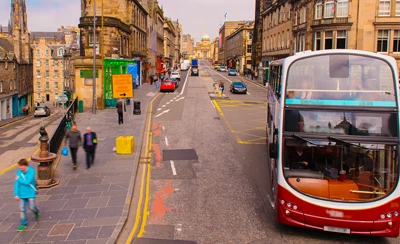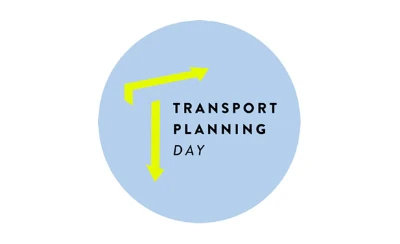Decarbonising Transport - A Better, Greener Britain
Transport Planning Society’s Full Response
Following the publication of the Transport Decarbonisation Plan (TDP) by the Department for Transport, the Transport Planning Society offers here its response; the timeliness and importance of the TDP is illustrated by the findings in the latest IPPC report Climate Change 2021: The Physical Science Basis. The plan offers a welcome, all-encompassing strategy for the transport industry to reach Net Zero by 2050 detailing how each mode will get there. Below, we respond to the strategy with reference to our report “State of the Nations: Transport planning for a sustainable future”, published last year (2020). The report offered 10 recommendations to the government clearly outlining how the transport industry should be moving forward regarding sustainability and decarbonisation, and these remain just as important as we go forward into the decade in which we must meet the decarbonisation challenge facing the country and the world.
As a Society we urge the government to follow through on the proposed actions in the TDP as soon as possible. The recent IPPC report Climate Change 2021: The Physical Science Basis makes for stark reading: climate change is already affecting every region across the globe even at current levels of warming. We believe that the wider population is ready for action: according to a recent poll a third of the British public see the environment and climate change as a big issue for the country1.
The Transport Decarbonisation Plan (TDP) and COP26
For the sake of clarity, we will outline the ten recommendations we made in our State of the Nations report and explore how the decarbonisation plan addresses them. We will then look forward to COP26 and see what government must do to meet our ambitions in light of the Climate Change Conference.
1. Transport planning needs to be more inclusive: it needs to unhook people from car dependence, giving them healthier and more sustainable travel choices, including travelling less. It also has to help tackle climate change; previous patterns of surface travel, dominated by private cars and trucks fuelled by oil, must change dramatically.
In terms of our first State of the Nations recommendation, the TDP includes both positives and negatives.
Dramatic change necessary
The significant £2 billion invested into active travel is commendable, particularly accompanied by the commitment that active travel will account for half of the journeys made in every town and city by 2040. But is it enough? This investment represents only around £6 per head of population per year. In comparison, in The Netherlands the government appears to spend some £25 per head of population2 per year.
We want to see more active travel funding committed each year.
Patterns of surface transport must change
And even as it promotes active travel, the overall tone of the strategy cannot fully break from the notion of planning transport to serve the car. The £27 billion committed to road transport in the Road Investment Strategy is more than for all other modes combined in the TDP. Throughout the document there tends to be a stronger focus on electrifying private vehicles than on reducing car journeys altogether.
The Secretary of State made multiple comments in the House of Commons when announcing the plan, as well as in the communications that accompanied it, that he is not anti-car. Yet surface transport has failed to reduce its greenhouse gas emissions, with recent trends showing an increase3. Electric vehicles are not emissions-free, whether embedded into the production of the vehicles, the generation of electricity or the emissions at street level from brake and tyre wear4. Reducing emissions will require unhooking people from car dependence so significantly fewer short trips are made by private vehicles, including electric vehicles.
More than just electrification – lifestyle and land use changes
There are tangible drawbacks to focusing solely on the electrification of private cars. Our end goal should not be to electrify all current car journeys. Estimates show that even if all vehicles were EVs, we would still need between a 20-60% reduction in road traffic mileage to reach our decarbonisation goal5.
First of all, more research is necessary to establish whether EVs are adding to or replacing the existing fleet (research from Norway, for example, suggests 15-20% of electric vehicles represent cars that would not have been purchased if there were no electric vehicles on the market)6. The EVs that are second cars do not directly replace older vehicles using petrol or diesel. In addition, it is worth noting that EVs will not be zero carbon vehicles until:
a) the electricity which fuels them is net zero. There is debate over when this date may be exactly, but even the most generous estimates recognise it’s unlikely to be in the next 10 years7. And;
b) embedded carbon tied to the manufacture of EVs is eliminated. These emissions would be more excusable if they were replacing the existing fleet but as we have mentioned this is not always the case. The carbon involved in manufacturing will decrease as we decarbonise the process but currently it is still a considerable amount. Government policy should address this gap.
Near term carbon reductions must instead take priority. Electrification of the vehicle fleet is not risk-free. Low operating costs may incentivise EV owners to drive more, unless some form of road pricing is introduced. Who owns EVs and are the benefits of reduced costs distributed fairly? Equality needs to be considered, so that access to off-street parking or not does not exclude certain parts of society of access to cleaner alternatives to the ICE in the run-up to net-zero.
Having said this, electrifying private vehicles for remaining essential trips, for which no easy carbon-neutral alternatives exist, is still a goal to work towards. Analysis by Professor Jillian Anable at the Institute for Transport Studies at Leeds University for example suggests that most carbon emissions from cars are for longer trips that are only really viable by this mode as a consequence of highly distributed origins and destinations. Unless spatial planning addresses this, EVs are an inevitable component in the future transport mix.
Address regional disparities in charging infrastructure
What is an absolute necessity for this shift for essential trips to be successful is for our charging infrastructure to meet the demands of a growing electric vehicle fleet. This means both sufficient charging stations correctly placed (on carriageways not on footpaths to allow for disabled travellers to use walkways), but also distributed evenly across the nation and reflecting both existing needs and the decarbonisation policy.
There is a disparity between London and the rest of the country. For example, 30.3% of UK charge points are located in the Greater London area8 while only 6.6%, 5.1% and 3.3% in the North West, Yorkshire & Humber and North East regions, respectively – totalling only 15% together. This is despite the fact these Northern regions’ populations amount to 6 million more people than in Greater London.
Increasing the number of overall charge points installed is a first step, but greater focus to ensure they are proportionately dispersed across the nation is critical to a fair and inclusive transition.
Universal charging points
Another logistical problem we need to overcome with our charging infrastructure is the varying types of plugs that EVs and charge points have. Different charge points offer different plugs reducing the availability and ease of charging and raising the threshold to EV adoption by consumers.
The government should commit to a universal charging infrastructure standard,
which we hope could be unveiled at COP26.
Micromobility
A mode that will likely play a major role in unhooking car dependence is the e-scooter. Research indicates that in car dominated areas (dense urban locations like European or Northern American capital cities) e-scooters have the potential to reduce the number of car trips by 8-50%9. Of course, e-scooters will be most effective when substituting for car journeys, rather than shorter journeys taken by bike or foot that provide health and community benefits.
A key concern for e-scooters is safety of riders and fellow road users, or perceived safety. While e-scooters are not without some safety issues, they are negligible when compared to the dangers of the car, both to those inside and outside the vehicle10.
If e-scooter schemes are successful, the DfT must accompany their introduction with strong marketing campaigns as well as safety awareness and training for riders to address these concerns, particularly surrounding privately owned e-scooters. Further effort is required in how government will support and regulate the safe deployment of e-scooters as an additional low-carbon alternative to the private car.
E-bikes are also crucial in unhooking car dependence and reducing emissions. Researchers at the University of Leeds found that if e-bikes were used to make car trips they could replace they have the capability to cut emissions in England by up to 50%, roughly 30 million tonnes per year11. E-mobility will be an important part of our route to net zero, and follow up actions from the TDP should establish how to integrate this into our transport systems.
2. Transport policies need to provide a clear route map to net zero by 2050 and to meet the five-year carbon budgets set under the Climate Change Act. This will involve “avoid, shift, improve” strategies – reducing travel through better planning, shifting travel from low occupancy motor vehicles to shared, active and sustainable transport, and electrifying and improving the motor vehicles. These policies should also inform transport spending priorities
The plan is to be commended for demonstrating a ‘route map to net zero by 2050’. It is the first of its kind to address how each specific mode will meet the government’s ambitions of net zero by 2050. The funding, political leadership and direction shown in the TDP are very welcome. Yet detail is sparse and most of the interventions aim to “improve”.
We would welcome further detailed funding plans on modal shift,
light or micro-mobility and embedded carbon in manufacture.
Spatial planning
The Transport Planning Society is a strong advocate for a better integration of land use and transport planning to reduce the need to travel. Embedding decarbonisation in spatial planning and across transport policymaking shows the government’s readiness.
The TDP is very light on “avoid” policies;
we would like to see stronger and earlier action.
Funding
Policies that focus on walking, cycling and public transport should be the priority to help achieve the necessary levels of traffic reduction (“shift”). It is also imperative that the accompanying funding is cost-effective at realising mode shift.
Cycling in the UK has consistently hovered around 2% of all journeys travelled, while the Netherlands provides a more successful model (27% of all journeys)12. We welcome the creation of Active Travel England to achieve the quality required. If Active Travel England receives the sustained funding it needs then the UK’s percentage of journeys travelled by cycles should creep up, particularly in our towns and cities, but we have concerns that it will not be enough to achieve the government’s own target of 50% of trips to be made by active modes by 2030.
As we mentioned before, the £2 billion attributed to active travel over a five year period is a welcome start, but this level of investment will have to be sustained moving forward if we are to match our Northern European neighbours.
Integrated behaviour change campaigns
The government should accompany investment in infrastructure with behaviour change campaigns that encourage a modal shift in response.
Funding is paramount, but persuasive communications and community engagement will be just as important in facilitating change.
Campaigns must stress how important it is to move to sustainable forms of transport in the immediate future. These campaigns must be sustained, not on/off activities linked to the success or otherwise of funding bids.
The rise of deliveries
The Department for Transport and local authorities must be able to respond to societal and economic shifts that lead to more emissions from transport. These often come in the form of unintended consequences, like the rise of deliveries associated with e-commerce. Last mile deliveries were initially expected to result in a reduction in emissions as less journeys were made by consumers. But now, growing demand for deliveries is expected to increase the number of vehicles in inner cities by 36% by 2030, leading to an increase in emissions of 30% in the top 100 cities globally in the same time frame if no action is taken13.
The government should support last mile deliveries by active and micro-modes to see fewer emissions from the emerging increase in the amount of transport demand.
New technologies such as drones may play a role; but we should not ignore what, for example, the humble bicycle can achieve: electric cargo bikes can deliver 60% faster than vans in urban centres, and cut emissions by 90% compared with diesel vans and by a third when compared with electric vans14.
3. The UK Government should draw up a national transport strategy for England to provide a framework for and to consolidate its different strategies and guidance.
As we have mentioned previously, the TDP addresses all modes of transport, threading them together into a thorough plan.
Areas for further exploration
There are areas of transport decarbonisation that require further attention. Data plays a key role in all transport systems, and we should be doing all we can to reduce the barriers to data sharing across the transport sector.
A transport data strategy may be desirable, but we must make sure it is accessible to local authorities and all stakeholders in general, keeping in mind both the resource and IT challenges that local authorities often face.
In implementing the TDP, the government should recognise the key differences felt throughout the UK between transport systems in rural, urban and suburban/peri-urban areas.
They typically require different solutions to decarbonisation – a uniform approach is detrimental to all. For example, the trialling of demand responsive transport networks suits rural areas better, yet if successful, could have positive impacts on both rural and urban areas. A shared mobility policy may allow such transport alternatives to become commercially successful in urban areas first, and lessons can be learnt before their introduction in more rural locations.
4. The Government should continue with devolution of transport powers and funding to local and city-region transport authorities and extend it elsewhere, reducing the fragmentation and complexity of transport decision-making and increasing accountability. In all three countries, local transport authorities and sub-national transport bodies should have the powers, duties and funding to tackle transport challenges, especially reducing carbon emissions.
We welcome the TDP’s response to this recommendation. The substantial £12 billion of funding committed to local transport systems over the current Parliament provides substantive backing to commitments from both the Prime Minister and the Secretary of State for Transport. Despite this, the TDP talks less about what powers and duties local authorities will have.
Local authorities must have autonomy over the funding they receive from existing streams like the Levelling up fund, Active Travel Fund and City Region Sustainable Transport settlements.
We support linking the funding to Local Transport Plans that target a reduction in emissions, particularly with the accompanied guidance into how local authorities can design sustainable transport systems to achieve emissions reductions.
5. New planning and devolution/local government plans in each country should promote integrated transport and spatial planning so as to reduce the need to travel and help tackle climate change and social exclusion. The Government’s proposals for reform of the planning system provide an opportunity to achieve this
In the TDP there is loose commitment to ‘embed decarbonisation in spatial planning’ (‘avoid’). This is a positive sign but is one area which will need further detail in subsequent strategies; what exactly will this look like?
The way land is used must serve the goal of reducing the need to travel, particularly by car. This means that new housing projects should always be constructed with sustainable transport links in mind, whether that is public transport or active travel.
We are pleased to see the promise to develop a Local Authority toolkit which would guide local authorities in their planning and policy making, specifically in reference to decarbonisation.
Spatial and transport planning remain disconnected for regional and local authorities outside London, and this should be addressed by government in future policy papers and strategies.
Carbon reductions
The government has committed to drive decarbonisation at a local level by ‘making quantifiable carbon reductions a fundamental part of local transport planning and funding.’ This is encouraging, but quantifying carbon reduction is complicated and challenging for local authorities who struggle for skills and resource. As the Institute for Government notes, “Central government grants – including retained business rates – were cut 38% in real-terms between 2009/10 and 2018/19”15.
Exact guidance on how to quantify or at least estimate carbon reductions, especially in the promotion and delivery of walking and cycling schemes where this is notoriously difficult, must be a part of the local authority toolkit mentioned above for authorities to put this into practice with any success.
6. Transport projects which increase carbon emissions must be withdrawn and funding for low and zero carbon transport projects and networks increased. The Governments should reduce the cost of using public transport and allow local authorities to do so in their areas.
Improvements to the quality and safety of existing road infrastructure will be positive but adding to road capacity runs absolutely contrary to the goals the government has clearly set out in the TDP. The government should recognise this.
Future budgets should redress the imbalance in funding between roads and sustainable forms of transport.
It is in stark contrast to the Welsh government, who suspended all new road building plans until the completion of an external review of all proposed schemes; the primary reason for this suspension was to meet net zero targets in 2050. The Welsh government will complement the postponement of road building with investments into alternative modes of transport to provide the Welsh population with meaningful transport choices.
Following the example in Wales, the government should assess suspending new road building as an approach for England, or at least commit to a review of the current Road Investment Strategy.
The commitment to review the outdated National Policy Statement for National Networks is very welcome.
Low carbon transport projects
There is significant government commitment to fund low and zero carbon transport projects. We welcomed the National Bus Strategy and Gear Change, for example, and their supporting £5bn of funding combined. Increased and sustained funding for these modes will be essential to support the required level of modal shift and associated carbon emissions.
Reducing the costs of public transport
We endorse the TDP’s commitment to “work with industry to modernise fares, ticketing and retail to encourage a shift to rail and cleaner and greener transport journeys.” As well as that vision we support that “We must make buses and trains better value and more competitively priced” particularly against the private car and short-haul aviation and would like to see concrete measures to make this a reality. We welcome news that the government is reconsidering the annual RPI-linked rail fare rise, for example.
The government must support the use of the large rail estate in the UK, using it to fit solar film panels onto station infrastructure, depots, control centres and offices, to power the stations themselves and produce surplus sustainable energy.
This process has already begun at some stations in the UK and should expand to include some of our larger stations where it will most likely prove even more effective16.
7. Local authorities should have a long-term funding regime for transport, so that they can plan ahead and spend effectively. Funding for packages of local measures to support zero carbon and sustainable transport should be increased. There should be more revenue funding to support transport services such as local bus and community transport services, which have important social and environmental benefits. Governments and local authorities should promote and fund “Total Transport” schemes to co-ordinate and bring together different transport services and funds from different public bodies.
Having £12 billion committed to local authorities over the current parliament on top of the other funding that is available to them through mode-specific investment may provide local authorities with a form of long-term certainty, yet under the surface it is not equally distributed regionally. If we compare the total service expenditure budgeted to 2021-2022 we see a 48% increase, but almost all of this can be accounted for in higher support to operators of Transport for London17. In the same time funding for local authorities outside of London will decrease18.
The government should recognise and address
regional funding disparities as a priority.
This is but one example of why the way funds are allocated to local authorities should be reformed.
TPS challenges the effectiveness of a competitive bidding system which often concentrates funding to the largest authorities/metro mayors. The government should increase the amount of ring-fenced funding so that all local authorities can commit to and continue to invest it into transport decarbonisation projects.
8. Future motoring taxes and charges should be reviewed to align with and support decarbonisation targets.
We welcome the government’s acknowledgement in the TDP that, “we will need to ensure that the tax system encourages the uptake of EVs and that revenue from motoring taxes keeps pace with this change, to ensure we can continue to fund the first-class public services and infrastructure that people and families across the UK expect”.
The TDP disappointingly makes no firm commitment to review the current fiscal incentives and disincentives in UK transport. This is a significant oversight of the decarbonisation plan, and the government should address how economic levers will be reviewed to not only achieve fiscal outcomes, but also support travel behaviour change.
A plan such as the TDP just cannot ignore the contribution that road user charging, at the local and national level, can make to decarbonisation.
The government must consider re-introducing the fuel duty escalator, to realise immediate carbon reduction from road travel that is still mainly dependent on the internal combustion engine.
A Government Business article19 estimates that ending the fuel duty escalator has cost the Treasury more than £50 billion since its discontinuation in 2011. That puts the £2 billion for walking and cycling over five years into a rather bleak perspective. The article also estimates that the freeze has led to 5% more traffic, 250 million fewer bus journeys, 75 million fewer rail journeys, an extra five million tonnes of CO2 and an extra 15,000 tonnes of NOx emissions.
A logical incentive system will be an essential mechanism for decarbonisation. Recent benefits arising from increased efficiency in vehicles, for instance, have been offset by increased vehicle size and use resulting in little to no net change in emissions from the sector20. Similarly, successful EV incentives in Norway have not necessarily led to reduced emissions from transport as they can lead to the purchasing of EVs as a second vehicle21. The government must ensure the design of incentives are considered carefully to achieve the intended results and avoid unwanted and unforeseen knock-on impacts. Motoring taxes and charges offer the clearest mechanism to ensure emissions do not continue to rise as efficiency improves, particularly with the significantly reduced running costs of electric vehicles.
9. Local authorities should have a wider variety of powers to raise funding for transport, as local authorities in other countries do, and should be encouraged to make greater use of existing charging powers such as workplace parking levies, to fund transport and to manage traffic and congestion.
While the specifics of what local authority powers could be aren’t included in the plan, the TDP does grant them the autonomy to raise funds through local transport schemes. The actions following TDP should specify what local authority powers could look like: for example, local authorities having greater control over their public transport networks to decide which services to run and what fares to charge. The National Bus Strategy started this with local bus networks, and further strategies should build on it offering a route for more local authorities to pursue a franchised system.
The national government is taking a stronger stance on pressing local authorities to use funds earmarked for transport schemes to manage traffic and congestion appropriately. Several London Boroughs, including Sutton, Wandsworth and Ealing, have recently had their active travel funding cut for prematurely scrapping schemes like express cycle lanes and low traffic neighbourhoods. It’s reassuring to see the national government hold local authorities to account in this respect.
10. The Government should conduct a fundamental reform of transport appraisal, forecasts and modelling and the business cases that result from them to ensure they support and deliver transport policy objectives.
The TDP promises a ‘complete review’ of how to represent decarbonisation in appraisals and business cases. This is welcome and necessary.
The first step to improving how appraisals and business cases represent decarbonisation and a key metric to adopt should be ‘tonne years CO2 equivalent’, which captures the importance of early action compared to later action, which is essential for any accurate climate modelling.
We welcome the government’s revised approach to valuing greenhouse gas emissions in policy appraisal22 although questions remain about the differential treatment of traded and non-traded emissions (they ultimately cause the same damage).
The way the appraisal system values travel time savings should be a part of the promised review of appraisals and business cases.
In many transport projects, the emphasis on time saved by motorists underplays impacts on other road users who are often underrepresented in data and modelling. The review should attempt to redress this balance to properly model and value all modes of travel, especially sustainable modes, in the light of their potential contribution to decarbonisation. Multimodality, shared modes and substitution of physical travel by virtual alternatives –the current TAG guidance fits and serves none of these well.
A long-term issue of the transport appraisal system has been the focus on monetary value as the primary concern, with cost benefit analysis having too much sway on how decisions are made. The natural environment and climate change need to play a larger role without simplifying and reducing these dimensions to just monetary items.
The government should consider the case for introducing a pass/fail grade for projects with regards to associated carbon dioxide emissions and their role in meeting our climate ambitions.
Our current appraisal system also struggles to recognise behavioural change. Forecasts remain firmly linked to travel behaviour embedded in past trends, so projects that encourage a change to travel patterns are hard to assess and their prospects overlooked. This includes cases that support economically deprived parts of the population where transport options are limited. This speaks to a larger problem where business cases miss those who want to travel but can’t, often the poorest and most marginalised communities.
A review of the appraisal system must recognise the significant role behavioural change will play in our decarbonisation plans, and the need for both fundamental research on alternative value mechanisms and more practical research on adapting existing data and modelling tools.
Finally, the government must develop studies that provide confidence that the targets can be achieved. Individual measures are presented in the TDP without evidence that they support the targets and to what extent, while targets are introduced without indication as to whether any of the interventions, individually or combined, can achieve these.
Conclusion
The TDP is ambitious in its scope and impressive in many ways. It weaves together multiple previous policies into a comprehensive strategy that addresses how each mode of transport will reach net zero by 2050. There are areas of weakness, as we have explored and challenged throughout this response. Rather than fixate on what the TDP should have included, however, we look forward to COP26 and explore what the government should do in the lead up to the Climate Conference and beyond.
Before COP26, we would like to see the government commit to a review of the Road Investment Strategy and the transport appraisal and business case systems, as well as a review of our motoring tax and incentive system in the light of electrification and decarbonisation.
The forum of COP26 should be used to launch new commitments that build on the TDP, for example, we hope to see the government unveil a commitment to a universal EV charging point standard.
Looking beyond COP26, in the early years of the decade within which we must cut emissions to keep global warming within 1.5 – 2°C to avoid catastrophic climate change23, action should concentrate on where the case for change is greatest.
Given the magnitude of emissions and the size of the error margin in the modelling for car (current emissions: 70MtCO2e) and aviation (current emissions: 40MtCO2e), the most immediate decarbonisation focus must be on reducing society’s dependence on those two modes and on cleaning them, rather than on the proposed rail or bus/coach interventions, which together add up to less fewer emissions (5MtCO2e) than the error margin in the forecasts for either aviation or car.
However, we would like to see recognition from the government that electrification of the vehicle fleet cannot be the sole answer, and that reducing journeys, particularly of private vehicles, is crucial.
Our detailed recommendations can be found throughout this document, are summarised in the Appendix and centre around:
- A careful approach to incentivising EVs
- Better integration of planning and transport
- Tackling regional disparities
- Sustained local authority funding and powers
- The need for fiscal (dis)incentives
- A fundamental review of appraisal practice
Contact
Main authors: Tom van Vuren (tom.van.vuren@veitchlister.com), Rose Yorke Barber (roseyorkebarber@gmail.com), Alex Bennett (alex@jfgcomms.co.uk) and Sarah McSharry (sarah@jfgcomms.co.uk).
Appendix: Summary of TPS recommendations
- We want to see more active travel funding committed each year.
- Increasing the number of overall charge points installed is a first step, but greater focus to ensure they are proportionately dispersed across the nation is critical to a fair and inclusive transition.
- The government should commit to a universal charging infrastructure standard, which we hope could be unveiled at COP26.
- If e-scooter schemes are successful, the DfT must accompany their introduction with strong marketing campaigns as well as safety awareness and training for riders to address these concerns, particularly surrounding privately owned e-scooters. Further effort is required in how government will support and regulate the safe deployment of e-scooters as an additional low-carbon alternative to the private car.
- We would welcome further detailed funding plans on modal shift, light or micro-mobility and embedded carbon in manufacture.
- The TDP is very light on “avoid” policies; we would like to see stronger and earlier action.
- Policies that focus on walking, cycling and public transport should be the priority to help achieve the necessary levels of traffic reduction (“shift”). It is also imperative that the accompanying funding is cost-effective at realising mode shift.
- The government should accompany investment in infrastructure with behaviour change campaigns that encourage a modal shift in response.
- Campaigns must stress how important it is to move to sustainable forms of transport in the immediate future. These campaigns must be sustained, not on/off activities linked to the success or otherwise of funding bids.
- The government should support last mile deliveries by active and micro-modes to see fewer emissions from the emerging increase in the amount of transport demand.
- The government should recognise the constantly changing nature of transport systems due to new technologies and encourage governing bodies to respond accordingly.
- A transport data strategy may be desirable, but we must make sure it is accessible to local authorities and all stakeholders in general, keeping in mind both the resource and IT challenges that local authorities often face.
- In implementing the TDP, the government should recognise the key differences felt throughout the UK between transport systems in rural, urban and suburban/peri-urban areas.
- Local authorities must have autonomy over the funding they receive from existing streams like the Levelling up fund, Active Travel Fund and City Region Sustainable Transport settlements.
- Spatial and transport planning remain disconnected for regional and local authorities outside London, and this should be addressed by government in future policy papers and strategies.
- Exact guidance on how to quantify or at least estimate carbon reductions, especially in the promotion and delivery of walking and cycling schemes where this is notoriously difficult, must be a part of the local authority toolkit mentioned above for authorities to put this into practice with any success.
- Future budgets should redress the imbalance in funding between roads and sustainable forms of transport.
- Following the example in Wales, the government should assess suspending new road building as an approach for England, or at least commit to a review of the current Road Investment Strategy.
- The government must support the use of the large rail estate in the UK, using it to fit solar film panels onto station infrastructure, depots, control centres and offices, to power the stations themselves and produce surplus sustainable energy.
- The government should recognise and address regional funding disparities as a priority.
TPS challenges the effectiveness of a competitive bidding system which often concentrates funding to the largest authorities/metro mayors. The government should increase the amount of ring-fenced funding so that all local authorities can commit to and continue to invest it into transport decarbonisation projects. - The TDP disappointingly makes no firm commitment to review the current fiscal incentives and disincentives in UK transport. This is a significant oversight of the decarbonisation plan, and the government should address how economic levers will be reviewed to not only achieve fiscal outcomes, but also support travel behaviour change.
- The government must consider re-introducing the fuel duty escalator, to realise immediate carbon reduction from road travel that is still mainly dependent on the internal combustion engine.
- The first step to improving how appraisals and business cases represent decarbonisation and a key metric to adopt should be ‘tonne years CO2 equivalent’, which captures the importance of early action compared to later action, which is essential for any accurate climate modelling.
- The way the appraisal system values travel time savings should be a part of the promised review of appraisals and business cases.
- The government should consider the case for introducing a pass/fail grade for projects with regards to associated carbon dioxide emissions and their role in meeting our climate ambitions.
- A review of the appraisal system must recognise the significant role behavioural change will play in our decarbonisation plans, and the need for both fundamental research on alternative value mechanisms and more practical research on adapting existing data and modelling tools.
- Given the magnitude of emissions and the size of the error margin in the modelling for car and aviation, the most immediate decarbonisation focus must be on reducing society’s dependence on those two modes and on cleaning them, rather than on the proposed rail or bus/coach interventions, which together add up to less fewer emissions than the error margin in the forecasts for either aviation or car.
Transport Planning Society’s Full Response. Following the publica1on of the Transport Decarbonisa1on Plan (TDP) by the Department for Transport, the Transport Planning Society offers here its response.
1 https://www.ipsos.com/ipsos-mori/en-uk/public-concern-about-climate-change-and-pollution-doubles-near-record-level
2 https://www.resilience.org/stories/2018-11-08/a-modest-investment-with-major-dividends-cycling-culture-in-the-netherlands/ )
3 https://www.cyclinguk.org/blog/decarbonising-transport-being-led-science
4 https://afdc.energy.gov/vehicles/electric_emissions.html
5 Lisa Hopkinson and Lynn Sloman, ‘Briefing More than electric cars; Why we need to reduce traffic to reach carbon targets, Transport for Quality of Life’, (2018)
6 Aasness M. and Odeck J. (2014) The explosion of electric vehicle use in Norway – environmental consciousness or economic incentives? Association for European Transport 2014 European Transport Conference, https://aetransport.org/public/downloads/8tuFk/4400-5400a2876cd3d.pdf
7 https://www.nationalgrideso.com/news/great-britain-track-periods-zero-carbon-electricity-2025
8 https://www.zap-map.com/statistics/
9 https://www.itf-oecd.org/sites/default/files/docs/safe-micromobility_1.pdf
10 https://www.itsinternational.com/its17/news/e-scooter-use-safer-cars-cities-itf-report
11 https://www.creds.ac.uk/e-bikes-could-slash-transport-emissions-and-get-britons-back-to-work/
12 https://www.xpat.nl/expat-netherlands/getting-around/introduction-top-3-modes-transport-netherlands/
13 https://www.parcelandpostaltechnologyinternational.com/news/delivery/urban-deliveries-expected-to-increase-carbon-emissions-by-30.html
14 https://www.rapidtransition.org/stories/large-tired-and-tested-how-europes-cargo-bike-roll-out-is-delivering/
15 Institute for Government (2020) Local government funding in England,
https://www.instituteforgovernment.org.uk/explainers/local-government-funding-england
16 https://www.theguardian.com/business/2019/aug/22/rail-line-in-hampshire-is-worlds-first-to-be-powered-by-solar-farm
17 https://assets.publishing.service.gov.uk/government/uploads/system/uploads/attachment_data/file/996192 /Local_authority_revenue_expenditure_and_financing_in_England_2021_to_2022_budget.pdf
18 Ibid.,
19 https://governmentbusiness.co.uk/news/10032020/ending-fuel-duty-freeze-could-treble-nhs-budget
20 https://www.ons.gov.uk/economy/environmentalaccounts/articles/roadtransportandairemissions/2019-09-16#greenhouse-gas-emissions-from-road-transport-make-up-around-a-fifth-of-uk-greenhouse-gas-emissions
21 Aasness M. and Odeck J. (2014) The explosion of electric vehicle use in Norway – environmental consciousness or economic incentives? Association for European Transport 2014 European Transport Conference, https://aetransport.org/public/downloads/8tuFk/4400-5400a2876cd3d.pdf
22 https://www.gov.uk/government/publications/valuing-greenhouse-gas-emissions-in-policy-appraisal/valuation-of-greenhouse-gas-emissions-for-policy-appraisal-and-evaluation
23 IPCC, 2021 ‘Climate Change 2021: The Physical Science Basis’








